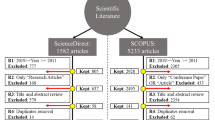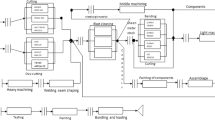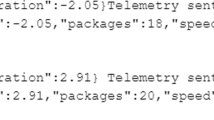Abstract
This paper presents an original approach for automatic construction of a simulation model for complex manufacturing systems. The model generation is based on spatio-temporal product trajectories, and it is detailed by the integration of heterogeneous knowledge & product data flows. The products, therefore, contribute directly to the control of the system. The formal generated model, a queuing network with spatial structure, is a permanent image of the real state of the system to be modelled; it can be described as being auto-adaptive.






Similar content being viewed by others
References
Adam, M., Cardin, O., Berruet, P., & Castagna, P. (2011) Proposal of an approach to automate the generation of a transitic system’s observer and decision support using MDE. Proceedings of the 18th IFAC World Congress, (pp. 3593–3598).
Bar-Yam, Y. (2003). Dynamics of complex systems (Studies in Nonlinearity). Boulder: Westview Press, http://www.worldcat.org/isbn/0813341213
Bourne, C. (1997). Catégorisation et formalisation des connaissances industrielles. In J. M. Fouet (Ed.), Connaissances et Savoir-faire en entreprise (pp. 179–197). Paris: Hermès.
Brown, N., & Powers, S. (2000). Simulation in a box: a generic reusable maintenance model. In: Proceedings of the 32nd conference on Winter simulation, Society for Computer Simulation International, San Diego, CA, USA, WSC ’00 (pp. 1050–1056).
Cao, B., Farr, R., Byrne, M., & Tannock, J. (2004) Data-driven simulation of the extended enterprise. 18th International Conference on Production Research.
Charpentier, P., & Véjar, A. (2013). A product trajectory-driven model builder for manufacturing systems. In: 11th IFAC Workshop on Intelligent Manufacturing Systems, IMS’2013, Sao Paulo, Brazil, vol 11, (pp. 324–329), doi: 10.3182/20130522-3-BR-4036.00032.
Cheng, B. H. C., de Lemos, R., Giese, H., Inverardi, P., & Magee, J. (2009). Software Engineering for Self-Adaptive Systems. Lecture Notes in Computer Science, 5525, doi:10.1007/978-3-642-02161-9.
Darema, F. (2004). Dynamic data driven applications systems: A new paradigm for application simulations and measurements. In: Bubak M, Albada, G., Sloot, P., Dongarra, J. (eds). Computational Science—ICCS 2004, Lecture Notes in Computer Science, vol 3038, Springer, Berlin Heidelberg, (pp. 662–669), doi:10.1007/978-3-540-24688-6_86.
Diaz-Calderon, A., Paredis, C., & Khosla, P. K. (2000) Architectures and languages for model building and reuse: Organization and selection of reconfigurable models. In: Proceeedings 2000 Winter Simulation Conference, (pp 386–393).
Fowler, J. W., & Rose, O. (2004). Grand challenges in modeling and simulation of complex manufacturing systems. SIMULATION, 80(9), 469–476. doi:10.1177/0037549704044324.
Garnier, H., Gilson, M., Bastogne, T., & Richard, A. (2007). Identification de modèles paramétriques à temps continu à partir de données expérimentales. Techniques de l’Ingenieur p, S7, 140.
Guru, A., & Savory, P. (2004). A template-based conceptual modeling infrastructure for simulation of physical security systems. In: Proceedings of the 36th conference on Winter simulation, Winter Simulation Conference, WSC ’04, (pp 866–873).
Kasputis, S., Ng, H.C. (2000). Model composability: Formulating a research thrust: composable simulations. In: Proceedings of the 32nd conference on Winter simulation, Society for Computer Simulation International, San Diego, CA, USA, WSC ’00, (pp. 1577–1584).
Koh, S., Gunasekaran, A., & Saad, S. (2006). Parts verification for multi-level-dependent demand manufacturing systems: a recognition and classification structure. The International Journal of Advanced Manufacturing Technology, 31, 305–315. doi:10.1007/s00170-005-0184-9.
Page, E.H., & Opper, J.M. (1999). Observations on the complexity of composable simulation. In: Proceedings of the 31st conference on Winter simulation: Simulation–a bridge to the future - Volume 1, ACM, New York, NY, USA, WSC ’99, (pp. 553–560), doi: 10.1145/324138.324433.
Revel, L., Habchi, G., & Maire, J. (2004). Analyse du processus d’élaboration d’un projet de simulation. In: 5ème Conf. Int. Francophone de MOdélisation et SIMulation, Nantes, France, vol 1, (pp. 293–301).
Robertson, N., & Perera, T. (2002). Automated data collection for simulation? Simulation Practice and Theory, 9(6), 349–364. doi:10.1016/S0928-4869(01)00055-6.
Sjöberg, J., Zhang, Q., Ljung, L., Benveniste, A., Delyon, B., Glorennec, P. Y., et al. (1995). Nonlinear black-box modeling in system identification: A unified overview. Automatica, 31(12), 1691–1724. doi:10.1016/0005-1098(95)00120-8.
Son, Y., Jones, A., & Wysk, R. (2000). Automatic generation of simulation models from neutral libraries: an example. In: Simulation Conference, 2000. Proceedings. Winter, vol 2, (pp. 1558–1567), doi: 10.1109/WSC.2000.899140.
Steele, M. J., Rabadi, M. M. G., & Cates, G. (2002). Generic simulation models of reusable launch vehicles. In: Proceedings of the 2002 Winter Simulation Conference, (pp 747–753).
Véjar, A. (2011). Génération de modèles de simulation adaptatifs, pilotée par les trajectoires produits. Thése de Doctorat: Université Henri Poincaré - Nancy I.
Véjar, A., & Charpentier, P. (2012). Generation of an adaptive simulation driven by product trajectories. Journal of Intelligent Manufacturing, 23, 2667–2679. doi:10.1007/s10845-011-0504-x.
Yang, M. (2008). Using data driven simulation to build inventory model. In: Proceedings of the 40th Conference on Winter Simulation, Winter Simulation Conference, WSC ’08, pp 2595–2599.
Zhou, M., Son, Y., & Chen, Z. (2004). Knowledge representation for conceptual simulation modeling. In: Simulation Conference, 2004. Proceedings of the 2004 Winter, vol 1, (p. 458), doi: 10.1109/WSC.2004.1371348.
Zhou, M., Zhang, Q., & Chen, Z. (2006). What can be done to automate conceptual simulation modeling? In: Proceedings of the 38th conference on Winter simulation, Winter Simulation Conference, WSC ’06, (pp. 809–814).
Acknowledgments
The authors gratefully acknowledge the financial support of the CPER 2007-2013 “Structuration du Pôle de Compétitivité Fibres Grand’Est” (Competitiveness Fibre Cluster), through local (Conseil Général des Vosges), regional (Région Lorraine), national (DRRT and FNADT) and European (FEDER) funds. The study is cofounded by the European Union from resources of the European Social Fund. Project PO KL “Information Technologies: Research and their interdisciplinary applications”, Agreement UDA-POKL.04.01.01-00-051/10-00.
Author information
Authors and Affiliations
Corresponding author
Electronic supplementary material
Below is the link to the electronic supplementary material.
Rights and permissions
About this article
Cite this article
Charpentier, P., Véjar, A. From Spatio-Temporal Data to Manufacturing System Model. J Control Autom Electr Syst 25, 557–565 (2014). https://doi.org/10.1007/s40313-014-0133-7
Received:
Revised:
Accepted:
Published:
Issue Date:
DOI: https://doi.org/10.1007/s40313-014-0133-7




